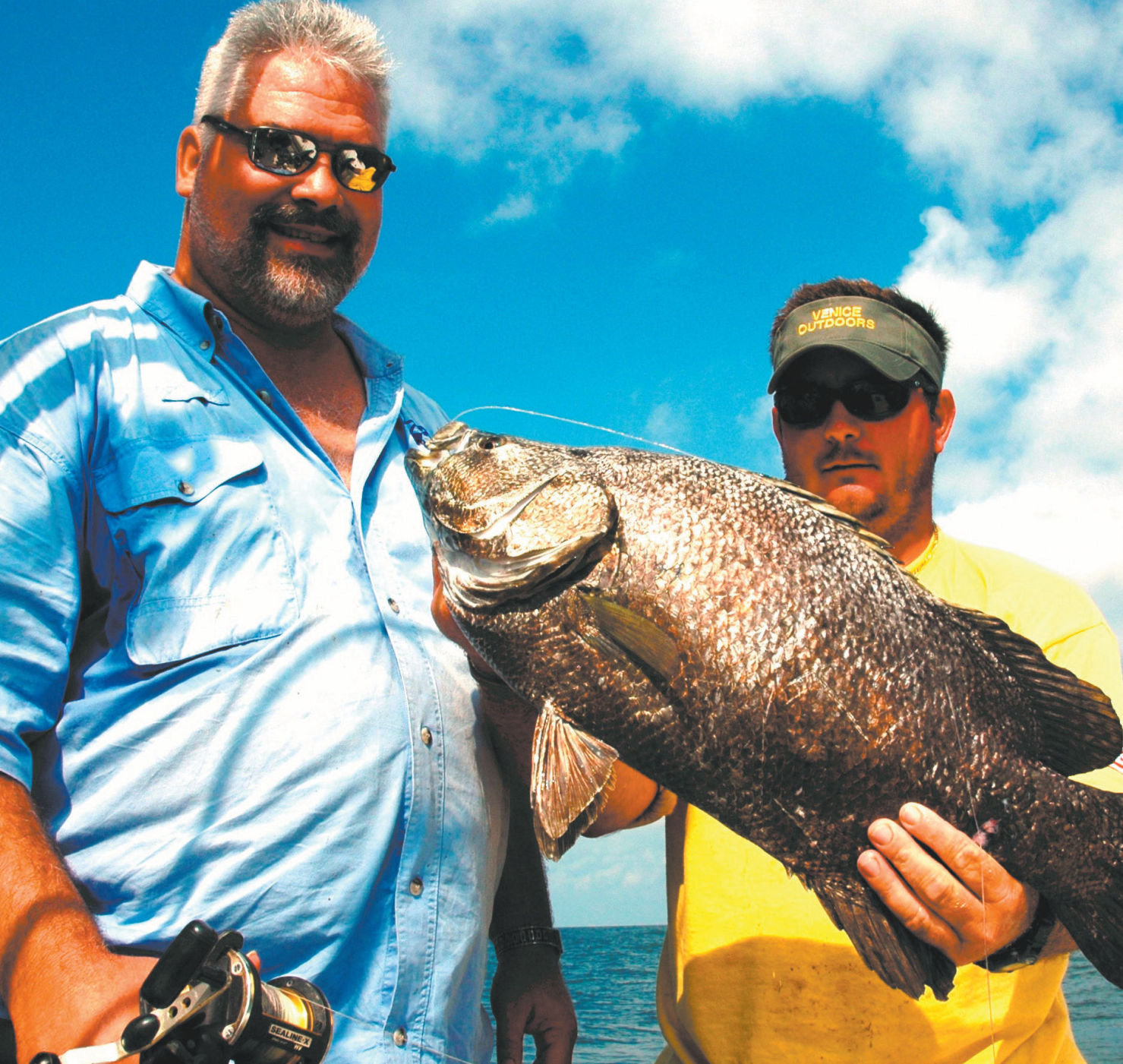
What qualities make a great teacher?
August 12, 2015
With offseason done, Saints seek to recreate winning ways
August 12, 2015Perched high in his flying bridge, the captain watched through polarized glasses as we passed near a floating board while heading back to port. Spotting a shadow, he turned the boat around as an angler grabbed a rod. The angler tossed a live shrimp dangling under a popping cork past the flotsam. WHAM! A dark circular object darted out from under the board to inhale the morsel.
Anglers don’t usually associate sight casting with fishing in deep water offshore, but keeping an eye open for targets of opportunity could put more fish in the boat. Often, people blast out to the wrecks, reefs and rigs to tempt snapper, amberjack, king mackerel and other species, but they might pass the most exciting action all day.
“Frequently, people run past hundreds of tripletail and don’t even realize they are fish,” advised Dr. Bob Shipp, (bobshipp.com) a marine biologist and author of Dr. Bob Shipp’s Guide to Fishes of the Gulf of Mexico. “A tripletail kind of looks like a floating clump of weeds. They don’t actively swim a lot. They just drift along until they see some bait.”
A tripletail somewhat resembles a giant bluegill on bad steroids with long dorsal and anal fins that make it look like a fish with three tails. They come in various shades of mottled yellow, reddish brown, black or gray. Also called blackfish, tripletail thrive in tropical to temperate seas around the world. Off North America, they range from Massachusetts to Peru, all through the Gulf of Mexico and along the Pacific Coast. Typically, tripletail weigh five to 20 pounds, but the world record, a fish caught off South Africa, exceeded 42 pounds. In late summer, thousands of tripletail thrive off the Louisiana coast. Few people leave port intentionally hoping to catch a tripletail, but the species does attract some fanatical enthusiasts. These unpredictable fish can give Cajun sportsmen a little lagniappe to catch when not fighting other species.
“Tripletail are kind of a ‘now you see them, now you don’t,’ fish,” explained Erik Rue of Calcasieu Charter Service (337-598-4700, calcasieucharters.com) in Lake
Charles. “It’s sight-fishing. It’s kind of like hunting. About 99 percent of the tripletail we catch, we see first. It’s a lot of fun to cast to them and watch them eat a bait. When I’m targeting tripletail, I get in an area with considerable floating debris and burn a lot of gasoline. We occasionally get them at the rigs, but most often, we have to find them before we can catch them.”
Frequently, tripletail hang around long weed lines. Anglers sometimes fish the floating weed patches almost as if working a marshy shoreline for bass or redfish, dropping baits into pockets or next to grass. Cruise along the edges looking for anything unusual. Look for splashes, bait jumping, fins protruding from the water or other indicators. Be ready to throw quickly at shadows. If people spook a fish, they can come back later to try again.
“We might find several grass patches with no life on them,” Rue advised. “All of a sudden, we find one with lots of bait and activity. That’s where tripletail will be. We can often run the motor right up to them and they sit under the log or grass without moving. I’ve caught them next to the boat with the motor running.”
During warmer months, tripletail frequently drift along with floating debris, such as logs, driftwood, old crates or other flotsam. Anglers might spot them hanging around objects as small as a drink can. They frequently appear near channel markers, petroleum platforms, crab trap buoys, docks and bridge pilings.
“Tripletail hover around anything,” explained Sonny Schindler of Shore Thing Fishing Charters (228-342-2295, www.shorethingcharters.com) who often chases ‘tails in Mississippi Sound and Lake Borgne. “It’s not the shade because we’ve seen them sunning themselves in open water or drifting with tiny objects. It’s because these floating objects give bait a place to hide. Shrimp, crabs and minnows congregate around these objects and tripletail wait there for them. Triple-tail can swim fast and strike quickly.”
After spotting a tripletail, watch tidal flow and wind direction to plan a stalk.
Some anglers shut off the motor upwind and drift toward the fish. Others prefer to approach from downwind so sound carries away from the fish and maneuver close with a trolling motor. Don’t shut down the outboard in a place where the wake might bounce against the object hiding the tripletail. Fortunately, tripletail usually don’t spook easily, even with people near them. Not a heavily pressured fish, they tend to remain near their object. They might sound for a while, but don’t leave the area.
“Sometimes fish go down, but usually we pull back a bit and wait a few minutes for them to pop back up,” Schindler recommended. “Sometimes, we send a bait down, but we risk snagging something and spooking the fish. The safest bet is to go elsewhere for a while and then return to that object later.”
When sight casting, don’t throw a bait right on top of the fish. Anglers may get multiple chances at a triple-tail, but make the first cast counts. Throw the lure or bait past the fish and bring it to the fish’s nose.
“Accurate casting is critical, particularly on the first cast,” Schindler advised. “Sometimes, anglers make a bad cast and fish get educated. If the bait lands two feet from the fish, it might not pull off the object to chase something. If they do pull away from the object too far, tripletail may not go back to it.”
Opportunistic feeders, tripletail devour various prey including pogies, minnows, shrimp, squid, small crabs and other morsels.
When fishing for tails, many anglers use live shrimp or baitfish on popping corks. Others prefer free lining.
“I like to use the biggest live shrimp I can find,” Schindler advised. “Even a 12-inch tripletail can suck down a jumbo shrimp. They also hit finger mullets and pogies. When we’re looking for tripletail, we bring different baits. If we keep throwing shrimp, they might get shy, but may respond better to a finger mullet.”
Tripletail sometimes hit artificials. Anglers tossing lures for speckled trout occasionally catch a tripletail or cast toward an opportune target that pops up. Anglers can catch tripletail on swim-baits, jigheads tipped with plastic shrimp or spoons. Lure placement typically matters more than lure selection.
“Tripletail will hit just about anything when they are feeding,” Rue confirmed. “I use a light leadhead to keep the bait close to the surface. A heavier bait might cause it to fall out of the strike zone too quickly. If they get finicky, I might tip a jig with a piece of bait or even toss them a live bait. Tripletail are excellent targets for fly fishermen. They readily eat a fly tossed at them. In open water, they generally jump and thrash on the surface, dive and run. They can burn off some line!”
People don’t need a 50-foot boat to run 60 miles offshore to find tripletail. Many anglers catch them in small boats just offshore or in many systems connected to the Gulf such as Barataria Bay, Terrebonne Bay, Lake Borgne, Lake Pelto and associated waters. Before heading home or when moving to another spot, keep an eye peeled for any shadows lurking under crab buoys, floating debris or weeds.
‘Frequently, people run past hundreds of tripletail and don’t even realize they are fish. A tripletail kind of looks like a floating clump of weeds. They don’t actively swim a lot.’
Dr. Bob Shipp
Marine biologist
Described by John Felsher (pictured at left) as a ‘giant bluegill on bad steroids,’ tripletail swim the Gulf of Mexico. The fish can be had in abundance throughout the summer months.
Tripletail provide a chance for the average man to net a worthwhile catch. According to Cajun Sportsman fishing expert John Felsher, the fish can be caught inside of 50-60 miles offshore in some of the calmest waters off the Gulf of Mexico. The fish regularly frequent waters in Barataria Bay, Terrebonne Bay and Lake Borgne.







